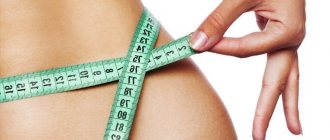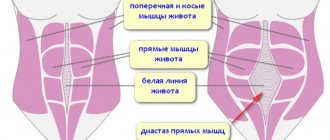And if you are a woman with a waist size of over 80 cm, this is already a serious problem. For men, the waist volume should not exceed 90 cm. But this is not the canon to which we should strive! This is the line that is dangerous to cross! Behind it comes obesity, and behind it come problems with the heart and more, since visceral fat (in the waist area) greatly complicates the normal healthy functioning of all internal organs.
So how do you find the willpower to lose weight? It's not difficult: you just need to answer some questions. Would you like:
- be healthy;
- receive attention from the opposite sex;
- have a prestigious job (Healthy, fit people are more often promoted up the career ladder.);
- have healthy children (An unhealthy body is not capable of producing healthy offspring.)?
- Think for yourself.
Without understanding an adequate algorithm of actions, no amount of willpower will help you, simply because you will not see the result. And so we smoothly approached N. Chernyshevsky’s question “What to do?”
- First we need to understand what fat is and how it makes our body fat.
- You need to know which foods contribute to the accumulation of excess weight.
- It is important to navigate the types of physical activity in order to understand which one will promote fat burning.
- It will be useful to implement cleansing techniques into your life.
- It is important to start loving yourself now, and it is out of self-love that you make efforts to become even better...
Having answered the above questions and mastered a clear algorithm of actions-skills, your willpower will begin to grow stronger for one simple reason: you will be able to see a way out of the current situation and the path to it.
What is fat?
The place of fat storage in our body is fat cells - lipocytes. There it is stored in the form of a chemical substance called triglyceride. In order for our body to spend it, the fat cell must break down this triglyceride into fatty acids and glycerin, which subsequently leave the fat cell into the blood and are transported to places of use.
The signal to start this process are hormones: adrenaline (when the body is preparing for an emergency load), glucagon (in response to hunger) and cortisol (in response to severe hunger, and even in combination with heavy physical or mental stress). And even if this breakdown process is started, we must understand that fat can only be burned: spent on the needs of the body (during a diet, for example) or through intense physical activity!
This is how fat is broken down, but how does it accumulate? The hormone insulin is responsible for filling the fat cell, the main task of which is carbohydrate metabolism, in particular the utilization of glucose in the body.
And here it becomes clear to us that not only the fat that we eat is responsible for the accumulation of fat, but also those carbohydrates (“fast”) that cause a sharp jump in insulin in the blood. And if we don’t get on the treadmill after eating a pie (I’m exaggerating), then the body will send this glucose straight into fat cells.
So-called fast carbohydrates:
- products made from premium flour;
- sausages;
- honey;
- store-bought sweets (drinks, soda, candy);
- soft wheat pasta;
- potato;
- canned fruits enriched with sugar;
- alcohol (in any form!!);
- sugar and products with its addition, ice cream, preserves, jams;
- fast food and almost all dishes in fast food restaurants.
About types of load
“How to lose weight: exercise” is a request from many who want to lose weight, and that’s great! You won't be able to lose weight without increasing physical activity. But mindlessly doing the exercises will be of little use. It is important to understand the essence of the fat burning training process.
During the day, when a person is active, he spends glucose, and at night he spends fatty acids - the deposits of our fat cells. Our body has both fuels, but as soon as we actively do something, then glucose is consumed, in the case when we are not in a hurry, we sleep, the nervous system works in a calm mode, the body will spend that - something less fast, but more energy-intensive, and these will be fatty acids.
This is a nocturnal method of energy supply. Thus, the well-known recommendation to go to bed early will allow you, at a minimum, not to have dinner a second or even third time, and at maximum, it will contribute to the consumption of fatty acids.
During the day, there is also the opportunity to burn fatty acids, but this again occurs in the resting stage. For example, during the day you are engaged in vigorous activity, and at some stage your blood glucose level drops sharply.
And you also decided to do some kind of training. As a result, first the body will empty all possible glucose storage depots, and only then, when you stop and calm down, it will spend fatty acids, perhaps even within 24 hours.
But there is such a danger here: the stronger and more intensely you train = burn calories, the less intensively the body will subsequently consume glucose deposits in its depots. The fact is that, when receiving excessive loads, the body experiences stress - and the brain sends a signal to the body about the need for the most economical expenditure of energy in order to survive.
Thus, a rollback occurs: instead of effectively burning calories and losing weight, the body will actively fill its reserve depots for future use and subsequently burn calories very sparingly. And it will look like this: you trained very hard and, when you come home, you feel very tired, lethargic and apathetic - this is what the body’s transition to energy-saving mode looks like.
Aerobic and anaerobic exercise
From here we smoothly move on to the concept of types of load. There are aerobic exercises and anaerobic exercises.
Aerobic exercise is long continuous exercise of moderate intensity (up to 50% effort). Such loads are the most wasteful of glucose. Examples of such loads include running, swimming, aerobics, fitness, and yoga, if the complex is a continuous dynamic.
Anaerobic loads are loads greater than 50% of effort in which muscles oxidize glucose without oxygen. This is an intense training, during which the muscle fiber contracts, the blood vessels contract, through which blood can no longer flow, which means that the nutrition that will ensure the muscles work will not arrive there.
As a result, the body intensively consumes the glycogen contained in this muscle, namely the muscle itself oxidizes glucose, but does it very uneconomically: only a small part of ATP is spent on the muscle performing its short but intense work, and the rest goes into lactate - into various acids, including lactic acid. The next day, these acids, which have a crystalline form with sharp edges, will injure the muscle tissue, causing pain.
Training in this mode greatly acidifies the blood, destroying muscle fiber. But not everything is so bad: it is in this mode that the body begins to produce anabolic hormones - those that will regenerate our body, restoring health and prolonging youth.
This is testosterone and samatotropic hormone. Therefore, we also need this kind of load. But if we excessively acidify our blood and destroy muscle fiber, then there is a chance that anabolic steroids simply will not have time to cope with the destruction.
Regular visits to the gym make the body elastic and toned.
By quitting classes, you run the risk of gaining extra pounds very quickly and losing shape. Therefore, I highly recommend not canceling your visits. If you've been doing it for a long time, keep doing it.
However, I want to focus on one point that many people miss. After forty years, a stage begins in the energy component of a person that is characterized by a lack of joy in movements.
I will try to explain this nuance in detail. Each of us has a specific energy program. Pay attention to small children, such as five-year-olds. They never walk - they always need to run somewhere, jump and gallop. A small child experiences joy from active movement, from running, from jumping. And this joy slowly fades away over the years.
At 18 years old, we are still active, we need to be on time everywhere, we have a lot of plans - jogging in the morning, clubs in the evenings, and guests, and parties. After twenty, the desire to move as much gradually decreases. Already at thirty we don’t feel much happiness because of jogging and going to the gym with weights and dumbbells. Well, after forty you shouldn’t expect this at all.
And then there are people who can maintain weight perfectly without any physical activity. During my practice I have...
Interval training regimen
And what happens: on the one hand, anaerobic loads destroy the body, on the other hand, they heal and rejuvenate. And how to find the middle ground between destruction and restoration? There is a way out: include in the training loads on both strength (anaerobic) and endurance (aerobic).
Interval loads successfully cope with this task. For example, according to the Tabata protocol, which is an interval mode - 20 seconds of exercise, during which glucose is consumed, but the blood is gradually acidified, then - 10 seconds of rest, during which fresh blood washes away acids from the muscle, and the glucose level is not fully restored is happening. And so eight approaches. During this time, the muscle begins to waste fatty acids.
As a result, you will spend both glucose and fatty acids, but without acidifying! It is short anaerobic training that is very effective for burning fat during and especially after training and for strengthening and growing muscles.
The sports industry today is replete with trends and trends that promise to restore youth and health. Approach your choice consciously: when signing up for classes with a particular teacher, learn as much as possible about him.
- How does he relax after training? Maybe he drinks beer every evening, then there is a chance of absorbing the same habit into himself. Without noticing it, we begin to resemble those on whom we regularly concentrate. Why such relaxation is dangerous, I think, explanations are unnecessary.
- Does he smoke? No comments.
- And, in principle, what he is like as a person. If a person is unpleasant to you, it is unlikely that your studies will be successful.
Today we can say that a direction such as yoga can compete with fitness and aerobics in terms of fat burning, and most importantly, in terms of how long the results are maintained. It is important to find a group that practices strength and dynamic sequences, including interval training.
Plus, yoga helps calm the mind and bring it into harmony with the body. And then you won’t have to eat stress and other troubles.
Eliminate unnecessary decisions
Have you ever wondered how many decisions you make on a typical day? From the simple ones, like what to drink with lunch, to the most important or complex ones, like negotiating that big sale you want to pull off. What about a week or a month?
Researchers at Cornell University estimate that we make about 200 decisions a day regarding food and drink choices alone, although most of them remain subconscious. Their total number seems gigantic. And each of them (primarily conscious) requires its own portion of willpower. Limit the number of decisions you make to focus on the ones that really matter.
Pre-planning is a very good way to minimize unnecessary dilemmas. In order to schedule your day hourly, you will need no more than 10-15 minutes. In the future, you will not painfully go through different options for action and will be less likely to commit an impulsive emotional act. You already have a route map - just follow it.
Cleaning techniques
When you decide on your diet and select an adequate load for yourself, it is important to understand one more thing: a thin body does not = a healthy body. A healthy body presupposes a certain internal purity, and I’m not talking about the spiritual world now (although this is the most valuable thing in a person).
Over a period of time, we all become quite heavily polluted from the inside: both at the organ level (for example, the small and large intestines) and at the cellular level. Therefore, to maintain the holistic health of the body, it is recommended to perform a number of cleansing techniques, both well-known (fasting days, for example), and little-known, such as yoga shatkarmas. Shatkarmas that can help solve problems with excess weight include:
- Shankha-prakshalana - cleansing the entire gastrointestinal tract (from the throat to the anus) by drinking a saline solution, performing a certain set of exercises and removing it naturally (due to which cleansing occurs);
- Vaman-dhauti - cleansing vomiting (Types: kunjala - vomiting with water (on an empty stomach), vyaghra-kriya - with water, but 3-4 hours after eating, gaja-karani - without water, after eating);
- Agnisara dhauti-kriya - manipulation of the abdomen, igniting the digestive fire, enhancing fat burning;
- Nauli - manipulation of the abdominal muscles to cleanse the gastrointestinal tract and improve its functioning;
- Kapalbhati is a cleansing breathing technique for warming up the entire body and improving the functioning of the gastrointestinal tract.
Be careful!! Each of these techniques has a considerable number of contraindications! Carelessness and lack of quality information about how to perform these techniques can lead to disastrous results.
How to love yourself
The answer is simple: start thinking about others. Start doing something useful and, if possible, selfless for others. How it works? Receiving gratitude from others (we don’t count on it, but well-mannered people always thank us in words), our self-esteem and sense of importance and need increase.
This is often what is sorely missing. At the energy level, we cleanse our manipura chakra, raising the energy higher. And if energy transits upward through the manipura, then excess weight will not accumulate.
Why am I doing this?
Motivation is what fuels willpower in the first place and is its strong foundation. If you don’t understand why you should do something, then it’s not surprising that you will shirk every time, and no exercises, tricks or life hacks will help you.
Therefore, start developing willpower from the main thing. Take time to figure out the goals you want to achieve in life and in the short term. By the way, in our opinion, this topic is described very well in J. Canfield’s book “A Whole Life.” Once you understand your goals and the actions you need to take to achieve them, it will be easier for you to activate your willpower.
It's even better if you paint a vivid picture in your head of how you will look, think and feel when you achieve your goal. Imagine it before your eyes every time you are tempted to deviate from your chosen path, and you will be able to resist. Let your willpower become better day by day by your conscious choice, and not by the influence of life's blows and circumstances. Remember your goals and never give up. As Michael Jordan said, “You're not a loser until you give up.”











